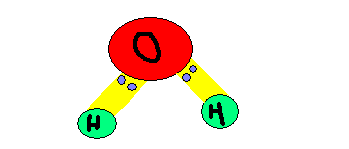
Key Types of Bonding in Chemistry

Course Menu
Polar Covalent Bonds
Polar Covalent Bonds are found on molecules such as in Water in the way that they deal with electronegative atoms attracting other smaller atoms. The most common elements that would be electronegaive when bonded to smaller elements are:
- Nitrogen
- Oxygen
Note that these are not all of the electronegative elements but these are the 2 most common.
The picture below shows how the molecules are attracted to eachother:

Water is the best example of polar covalentb bonding. As the picture shows the yellow area is the free area for the electrons to roam between the 2 atoms that are covalently bonded. Notice how the purple circles(representing electrons) are staying close to the Oxygen atom thus making it slightly more negative than the hydrogen which become slightly more positive. Just something to understand that there is no real charge on this molecule because the electrons are still shared. The only way there would be a charge on it is if it were forming an Ionic Bond.
If you have further questions and would like to discuss the problems that you are having feel free to contact me at:
Melanie Lalonde123 Fun Street
Winnipeg,MB, T3C4C6
or if it is more convient you can always e-mail!
*copyright 2009 by Melanie Lalonde* *Internet Explorer V 8*